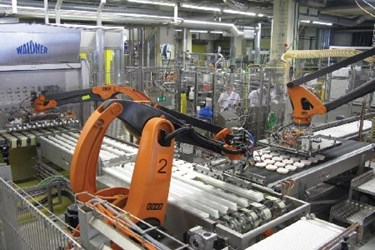Where Do Robotics And Automation Fit In Food Processing's Future?
By Isaac Fletcher, contributing writer, Food Online

Despite having to overcome unique needs and challenges, great progress has been made toward making robotics technology ubiquitous throughout the food manufacturing industry
In nearly every industrial sector, robots have changed the manufacturing process, boosted production efficiency, and increased product consistency. Interestingly, the food manufacturing sector had long been an exception to this trend, but improvements in methods and technology are changing that. A major reason for the sector’s slowness in adopting robotics has to do with the fact that foods differ greatly in consistency and shape from one product to another, which creates a large hurdle for automated processing.
Case Study: Automation Provides Flexible Packaging Line for Chocolate Manufacturer
As with many industrial sectors, the food manufacturing industry is made of manufacturers that are very small, very large, and every size in between, but a large portion can be classified as small-to-medium-size enterprises (SMEs). While larger manufacturers often use state-of-the-art automation, it is far less common for SMEs. This can be largely attributed to the lack of funds available for technical infrastructure and engineering research and development. Because food manufacturers regularly face pressure to reduce costs, increase competitiveness, and improve hygienic and environmental standards, robotic technology could prove to be of great value, even to SMEs and smaller manufacturers.
As previously noted, SMEs have been slow to adopt robotics due not only to lacking funds, but also the belief that automation is often unsuitable for the assembly of soft, inconsistent, fragile, or slick natural products. Accordingly, this issue has affected the way the food industry has evolved, and has resulted in heavy reliance on manual manufacturing, especially with regard to SMEs. However, manual manufacturing has its drawbacks and presents various challenges such as difficulty in adapting to market trends and scarcity of cheap labor.
PMMI Guest Column: What's Driving The Rise Of Robotics In Food Manufacturing?
Luckily, great strides have been made in robotics technology in order to accommodate the various challenges holding smaller manufacturers back from automating production processes. When products are regular in shape and size, the automation process is typically simple and straightforward. However, when product dimensions are irregular, automation becomes more complex, but the combined use of robotics and electromechanical systems is changing that. In fact, advancements in technology — such as imaging/sensor systems and computer software — have provided the tools to make possible the automatic manufacturing of most food products.
In the future, many food manufacturing procedures will remain the same — manual operation will continue for certain markets and products, but will be appropriately supplemented with automation wherever possible. As always, market forces will play a key role in shaping the industry and determining which tools manufacturers need in order stay competitive. It will be up to the automation industry to meet the demand for such tools so that food manufacturers can create readily available, high-quality, affordable food products.
Perhaps the biggest challenge the food industry will face in achieving such a future is finding enough engineers to make the universal adoption of robotics and advanced manufacturing techniques possible. Therefore, schools and other educational institutes share the burden in creating the food manufacturing industry of tomorrow.
